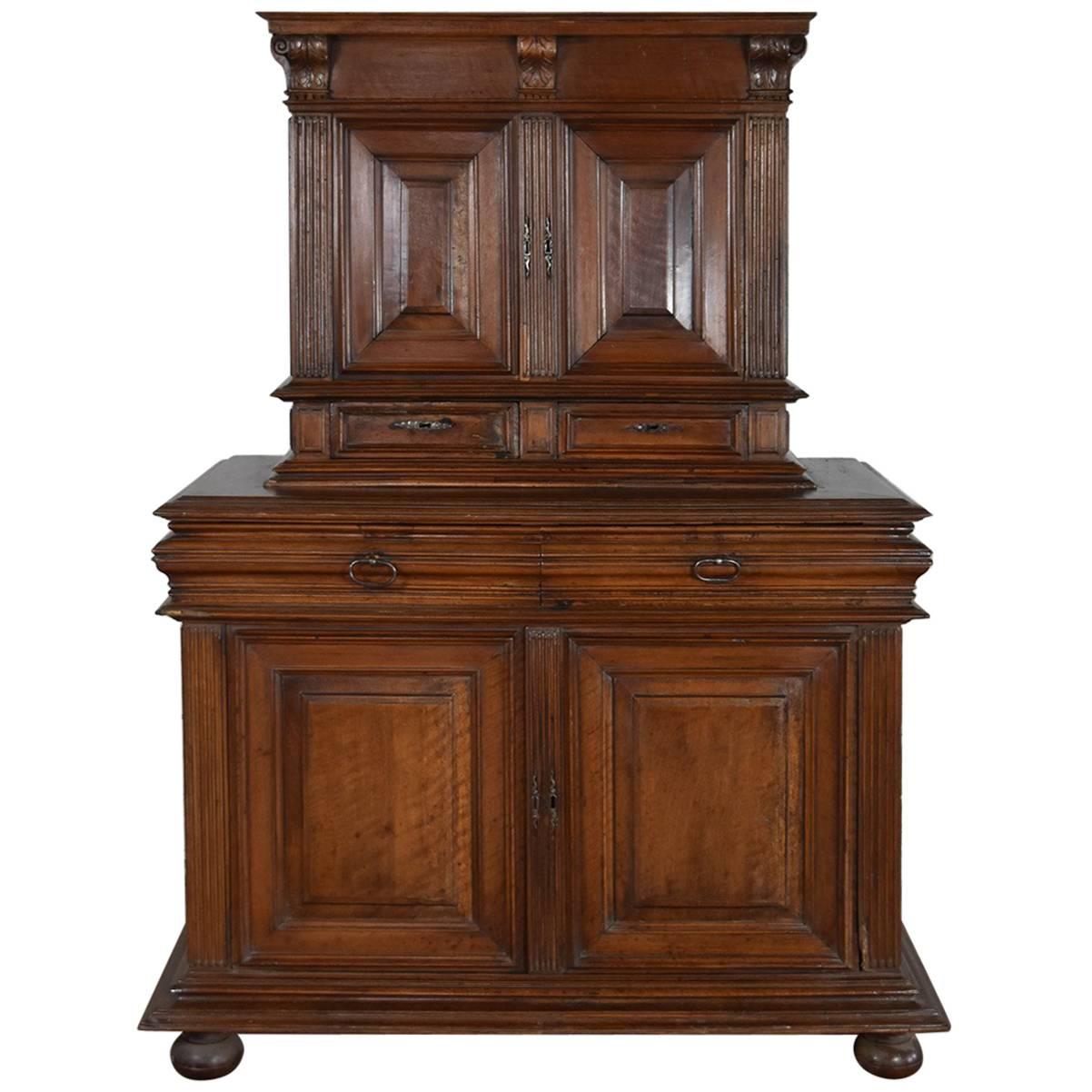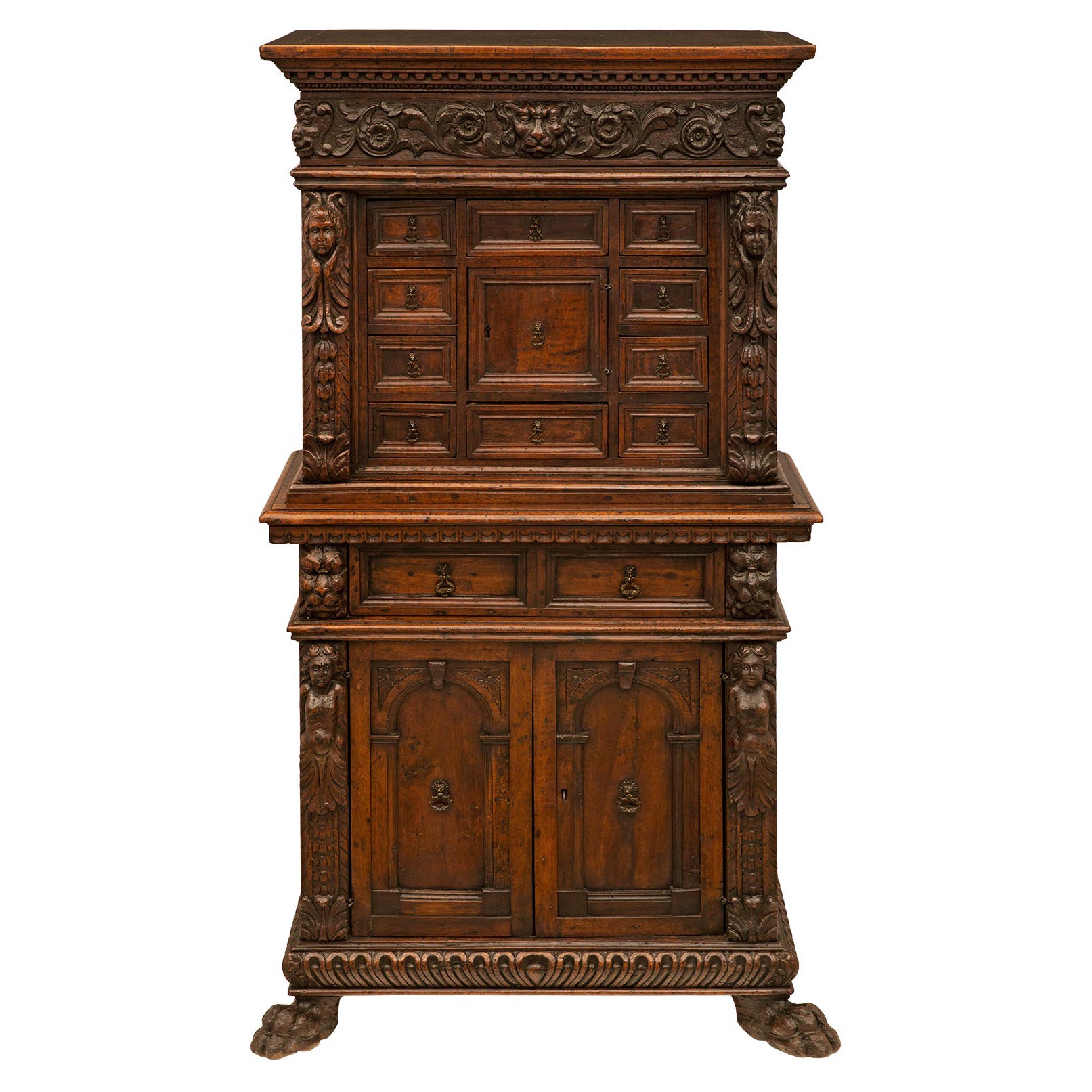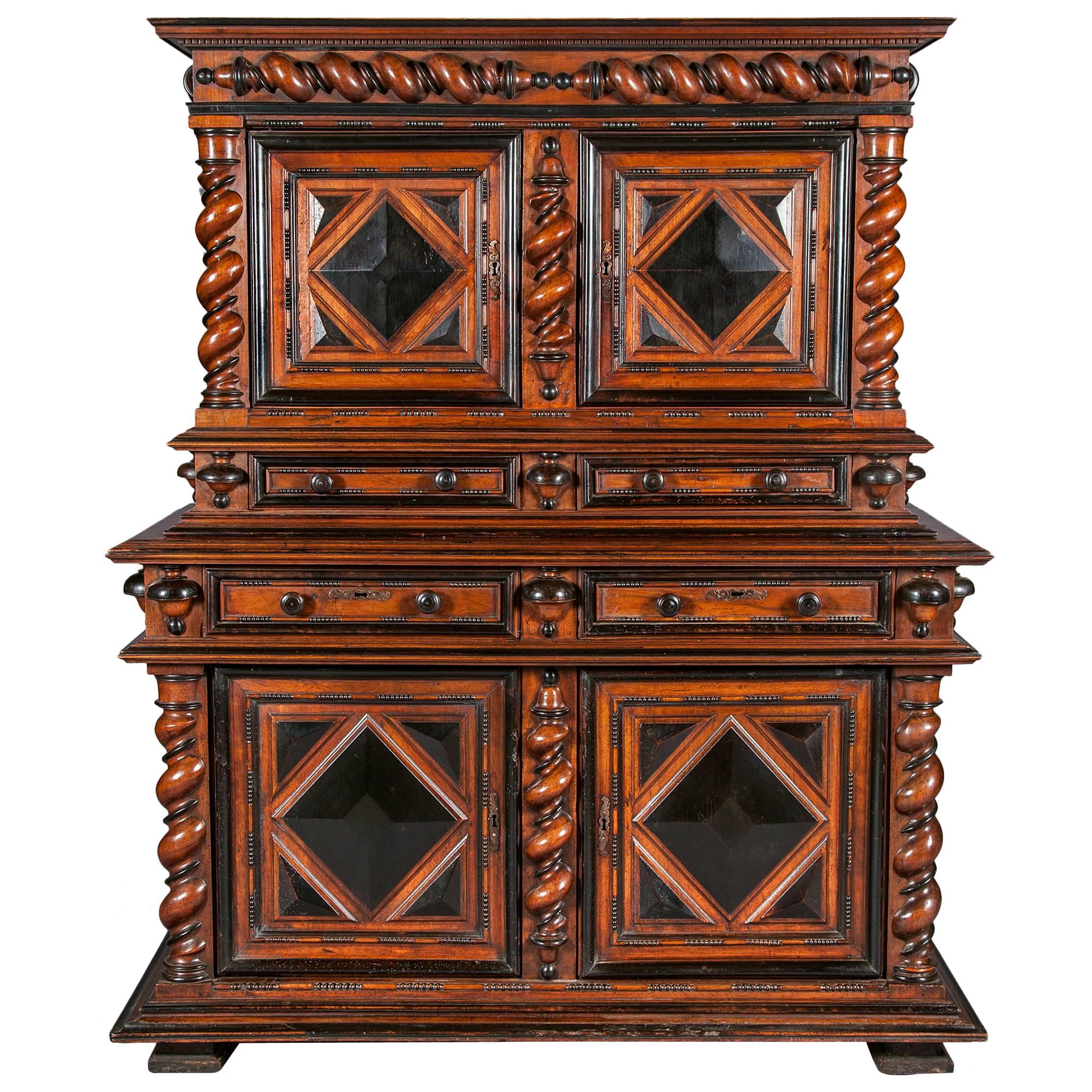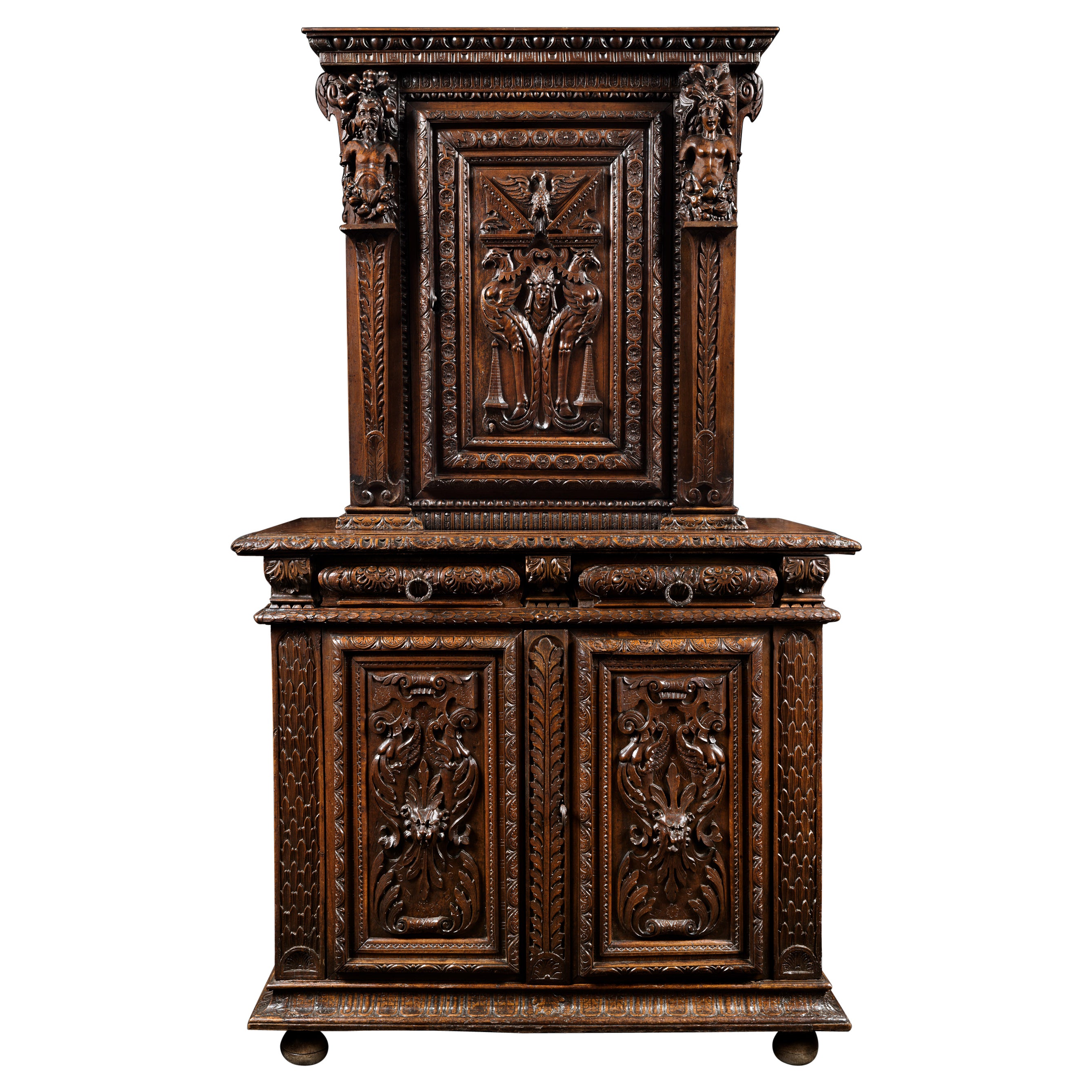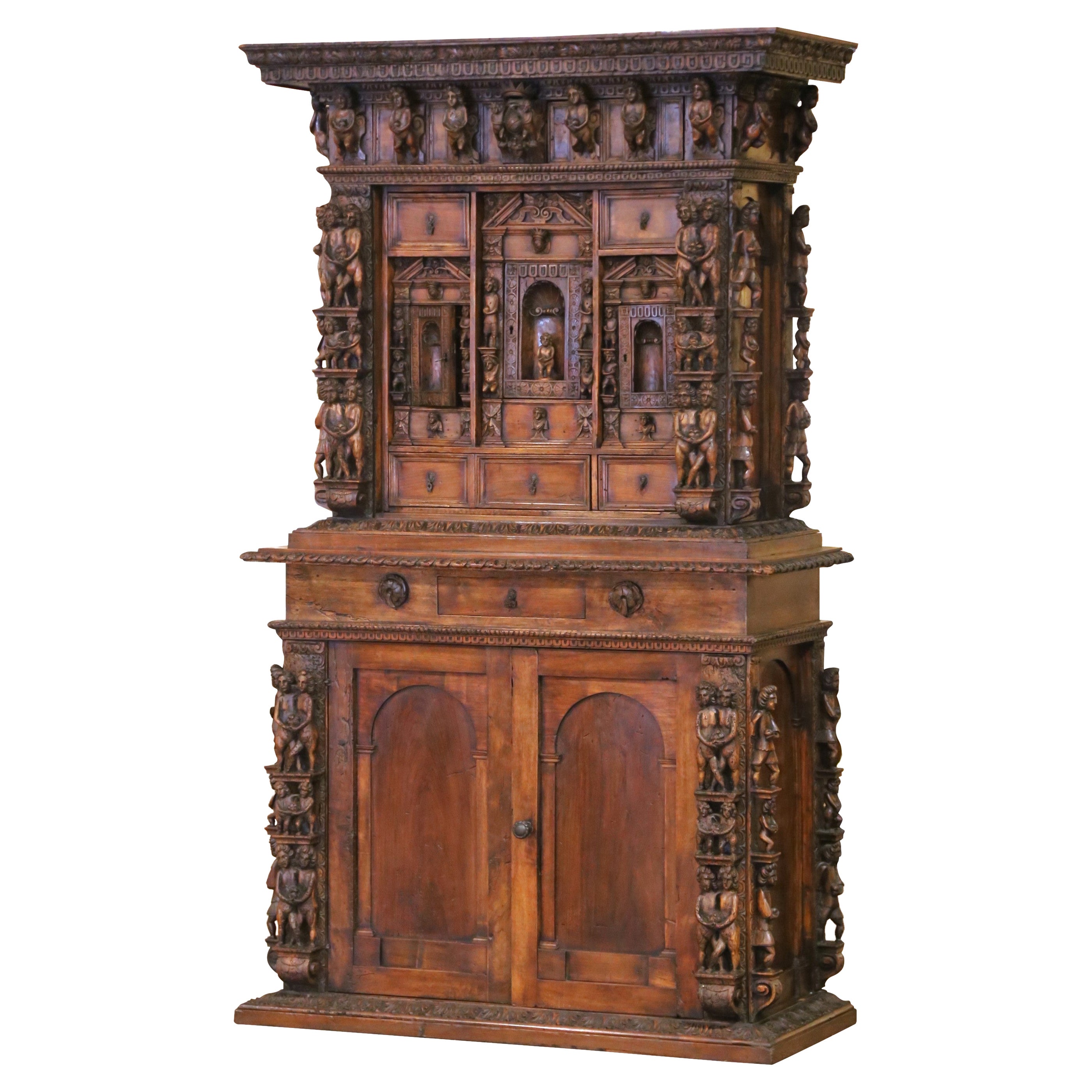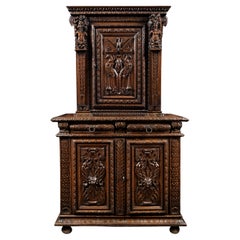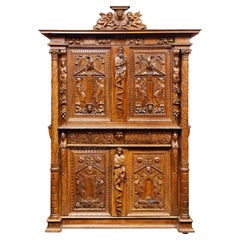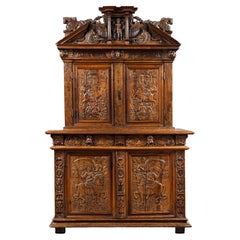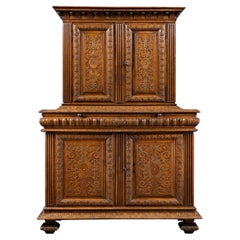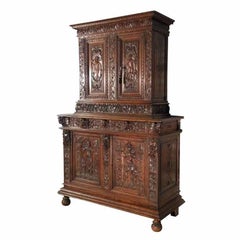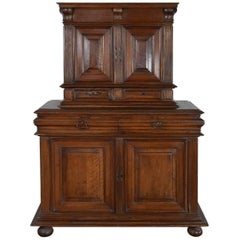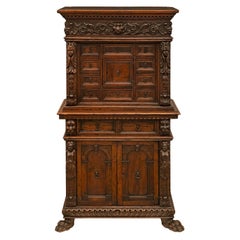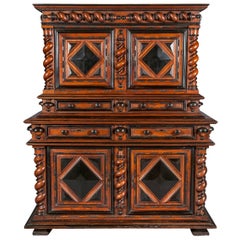Items Similar to 16th Century French Walnut Cabinet with Marble Inlays
Want more images or videos?
Request additional images or videos from the seller
1 of 8
16th Century French Walnut Cabinet with Marble Inlays
$29,715.67
£22,128.91
€25,000
CA$41,026.50
A$45,483.94
CHF 23,903.58
MX$556,648.82
NOK 298,531.47
SEK 280,201.65
DKK 190,341.67
About the Item
On the left post of the lower body, is written the date 1596 in a cartouche
This cabinet has two bodies. The upper part, set back, is moulded and carved. At the bottom, the cabinet opens with two doors surmounted by two drawers, and at the top by two doors.
The upright-beams, column shaped, are decorated with foliage scrolls. The doors are decorated with low reliefs medallions representing the muses and goddesses. On the upper body are depicted, on the right, dance, and on the left music, while the characters of the lower body evoke the hunt.
The upper part is inlaid with four inserts of sea green marble. It is surmounted by a triangular pediment at the top.
This Bellifontaine influenced furniture is in good condition. The wood and its ironwork, including latches and hinges, are original.
- Dimensions:Height: 72.84 in (185 cm)Width: 43.31 in (110 cm)Depth: 19.69 in (50 cm)
- Style:Renaissance (Of the Period)
- Materials and Techniques:
- Place of Origin:
- Period:
- Date of Manufacture:1596
- Condition:
- Seller Location:Saint-Ouen, FR
- Reference Number:1stDibs: LU3115327214182
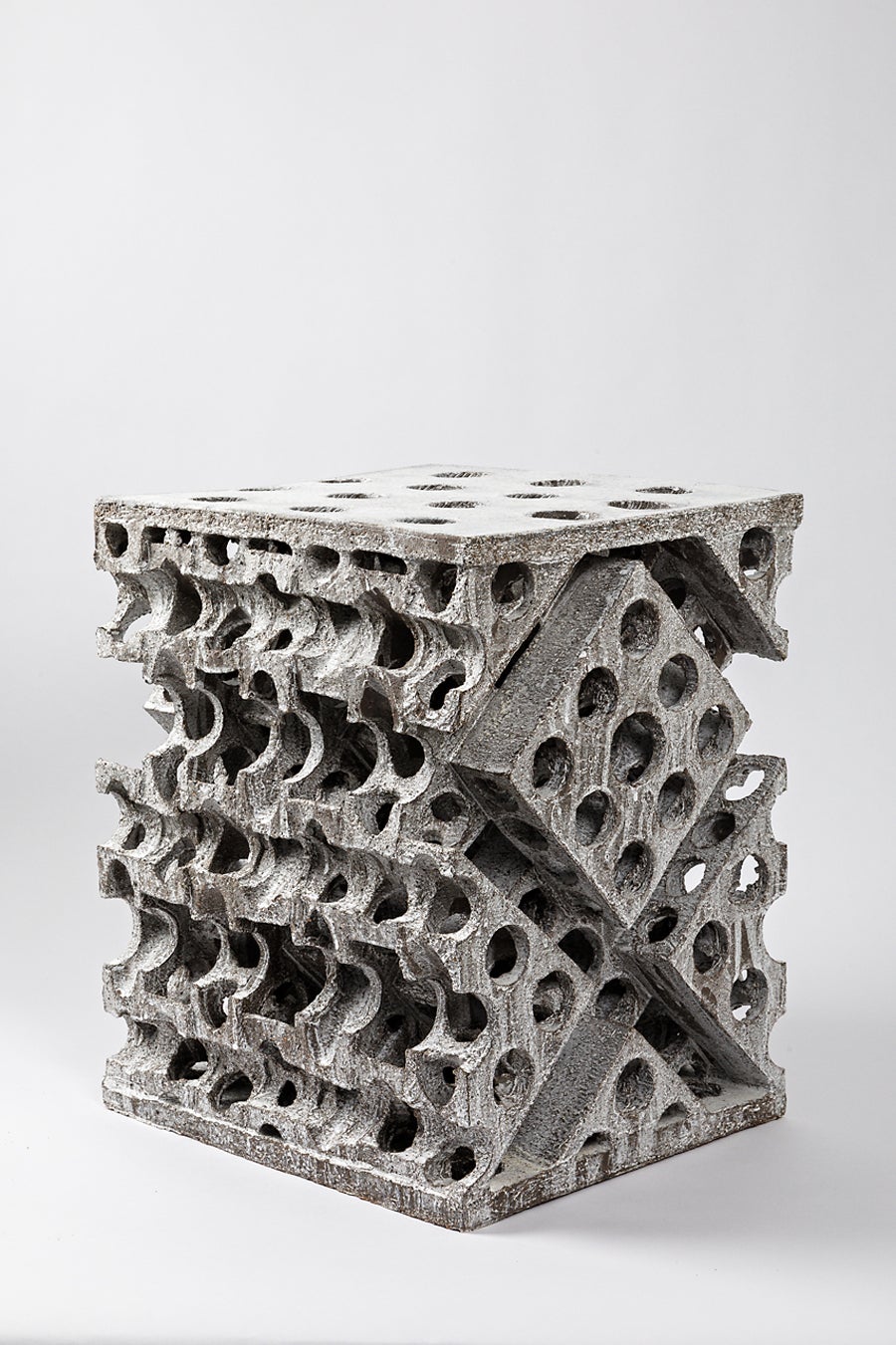
About the Seller
5.0
Vetted Professional Seller
Every seller passes strict standards for authenticity and reliability
Established in 2016
1stDibs seller since 2017
193 sales on 1stDibs
Typical response time: 2 hours
- ShippingRetrieving quote...Shipping from: Saint-Ouen, France
- Return Policy
Authenticity Guarantee
In the unlikely event there’s an issue with an item’s authenticity, contact us within 1 year for a full refund. DetailsMoney-Back Guarantee
If your item is not as described, is damaged in transit, or does not arrive, contact us within 7 days for a full refund. Details24-Hour Cancellation
You have a 24-hour grace period in which to reconsider your purchase, with no questions asked.Vetted Professional Sellers
Our world-class sellers must adhere to strict standards for service and quality, maintaining the integrity of our listings.Price-Match Guarantee
If you find that a seller listed the same item for a lower price elsewhere, we’ll match it.Trusted Global Delivery
Our best-in-class carrier network provides specialized shipping options worldwide, including custom delivery.More From This Seller
View All16th Century French Carved Renaissance Cabinet
Located in Saint-Ouen, FR
Rare carved Renaissance cabinet
Period : 2nd half 16th century, ca. 1570
Origin : France, Burgundy or Languedoc
This cabinet embody the produ...
Category
Antique 16th Century French Renaissance Cabinets
Materials
Walnut
A Rare Renaissance Walnut Cabinet With Its Freestanding Carved Columns
Located in Saint-Ouen, FR
A RARE RENAISSANCE WALNUT CABINET WITH ITS FREESTANDING CARVED COLUMNS
ORIGIN : FRANCE, BURGUNDY
PERIOD : 16th CENTURY
Height : 218 cm
Length : 152 cm
Depth : 67.5 cm
Walnut
Thi...
Category
Antique 16th Century European Renaissance Cabinets
Materials
Wood, Walnut
16th Century Cabinet with Knights Carving from Avignon Workshops 'France'
Located in Saint-Ouen, FR
Collection Jean Thuile
Around the mid-sixteenth century French furnishing evolves in its conception and ornamentation. The start of major archi...
Category
Antique 16th Century French Renaissance Cabinets
Materials
Walnut
Exceptional Renaissance Cabinet from Lyon
Located in Saint-Ouen, FR
Exceptional Renaissance Cabinet from Lyon
Origin: Lyon, France
Period: 1540-1580, Second French Renaissance
Measures: Height: 188 cm
Length: 132 cm
...
Category
Antique 16th Century Cabinets
Materials
Walnut
Rare Renaissance Dresser with Marquetry and Pastiglia, from Alsace 'France'
Located in Saint-Ouen, FR
This sideboard, with rich marquetry decoration, consists of two parts. The decorated upper body allows for the display of fine silverware. Superb carve...
Category
Antique Early 17th Century French Renaissance Dressers
Materials
Walnut
Important Renaissance Cabinet from Lyon 'France' with a Decor of Perspectives
Located in Saint-Ouen, FR
As soon as 1540 France's second Renaissance is in the making, intimately linked to the rediscovery of the Antique world. The development of the printing and engraving industry allows the spread of artworks and models in many cities and countries. The Italian influence can be perceived in every artistic field. While the French king entrust the most talented Italian artists with major projects such as Il Rosso or Primaticcio in Fontainebleau, French artists also travel to Italy to form themselves to this new style. In Italy they get acquainted with the work of Leo Battista Alberti the first to theorize perspective (De Pictura, 1435-36) and architecture (De re oedificatoria, 1541). Those two publications would have a revolutionary impact on arts.
Furniture is marked by the work of the most famous Italian architects of the time as well as French architects. Indeed Philibert de l'Orme competes with Alberti and by the end of his life publishes several treaties including one devoted to a theory of architecture (1567). Unfortunately he would not live to complete the second volume. In this treaty he expresses his interest for mathematical norms applied to architecture, copied from the Antique. His journeys in Italy allowed him to accumulate the most sophisticated references. Jean Bullant, another architect of great talent also theorizes his practice. He establishes rules characterizing Greco-Roman art staying faithful to Vitruvius.
Following this new inspiration the structure of furniture evolves. From then on appear columns, capitals, cornices, friezes and architraves. The ornamentation uses this inspiration as well with egg-and-dart, palm leaf and rose adorning the most beautiful pieces.
In Lyon, crossroad where meet merchants from everywhere those new experiments are welcomed. Lyon florishing printing industry allows the spreading of models and treaties essential to the artist's work. Thus the first publication of Vitruvius' De Architectura in France would be printed in Lyon in 1532.
Artists from Lyon rediscover and familiarize themselves with the Antique knowledge very early. They adopt those new ideas and use them in their own creations. Lyon cabinet-makers re interpret Antique architecture and Italian Renaissance palaces to give their pieces a pure and harmonious architectural structure. Grooved pilasters are particularly favored. They are topped by capitals of diverse orders always respecting the sequencing with simpler ones for the lower levels and the richest ones on the higher levels. As for the ornamentation, one of the great distinctiveness of Lyon workshops remains the architectural perspective illusions, drawing inspiration from Tuscany.
True masterpiece of the Second French Renaissance this important cabinet illustrates Lyon workshops' taste for fine Italian architecture inspired by Antiquity. An architectural perspective of great quality is treated in symmetry on each panel.
This two-bodied cabinet without recess stands on four rectangular feet. The base comprises a molding, a palm leaf frieze and is bordered by a braid.
The lower body is divided by three grooved pilasters with Tuscan capitals framing two door-leaves. The two panels are encircled by a moudled frame with palm leaves. They are finely carved with a decor of fantasized architecture depicting an Italian Renaissance palace erected symmetrically on each side of a grooved pilaster. On the ground floor a door opens through a stilted arch while the stories are opened with mullioned windows, dormers and occuli. Two large pegged-boss cladded pillars support the entablature enriched by a palm leaf frieze upon which stands an arch whose coffered intrados is centred by a rose. Behind this arch a pyramid appears, standing in front of a second facade with a window topped by a broken curvilinear pediment under a cul-de-four with a shell.
The checker flooring gives depth to the low-reliefs creating vanishing points structuring the panels and guiding the eye of the observer.
A thin laurel braid highlights the belt of the cabinet where are located two drawers. Their facades are adorned by palm leaves in hoops.
The upper body is encircled with palm leaves. The same ternary division as in the lower body appears. However, the pilasters are topped by Ionic capitals with volutes and egg-and-dart. The door-leaves are framed with flowers. On the panels the artist has designed another architectural decor. On the foreground open two arches on top of grooved pilasters with rectangular capitals adorned with palm leaves. The arches are enriched with braids and the coffered intrados bears a decor of roses. The spandrels also bear a flower decor. In the background another arcature hosts a fluted grooved column topped with double basket acanthus capital, characteristic of Corinthian order. The triangular pediment is interrupted by a choux bourguignon.
A large cornice crowns the cabinet. It stands on pilasters and forms an entablature comprising a palm leaf frieze and an egg-and-dart, triglyph and palm leaf cornice.
The cabinet's sides have also been carefully considered. The lower body's panels are enriched with an arch rising above a broken pediment portico hosting a twisted column. Flowers garnish the spandrels. An architectural facade completes the decor. The upper body's panels present two arches supported by a facade opened with dormers and mullioned windows as well as cartouches (one bears the inscription 1580 dating the cabinet) suggesting the interior of an Italian Renaissance palace, confirmed by the chandeliers. The flooring leads our gaze to a second arch with a broken curvilinear pediment where stands a flower vase. This arch opens onto a perspective of another facade along a road.
Inside the cabinet, on the lower body door-leaves appear two designs. On the right door is depicted a Crucifixion. Saint Mary and Saint John flank the Christ on the cross. In the bottom part is inscribed « Dure uiator abis nihil haec spectacula curas / Pendenti cum sis unica cura Deo. / Tota suo moriente dolet natura Magistro. / Nil qui solus eras caussa dolenda doles. ». The signature [Christoff Swartz Monachiensis pinx[it] / Ioa[nnes] Sadeler sculp[it]] tells us it was made by Johan Sadeler I (1550-1600) after Christoph Schwartz (1548-1592). This engraving belongs to an ensemble depicting the Passion of Christ Johan Sadeler executed in 1589 after an altar piece painted by Christoph Schwartz for the private chapel of Renée of Loraine, wife of Duke William V of Bavaria. This altar piece made of nine copper panels has been destroyed during the 19th century. The Crucifixion panel once in the centre of the altar piece is the only one that survived and is today kept in Munich's Alte Pinakothek.
On the left door appears Saint Francis receiving the stigmata. The inscription says : « Signastidomine Servum Tuum. Franciscum. Signis Redemptionis Nostrae ».
This Renaissance cabinet with an architectural decor appearing as much in the structure faithful to Antique rules...
Category
Antique 16th Century European Renaissance Cabinets
Materials
Walnut
You May Also Like
French late 16th century Renaissance Walnut Deux-Corps cabinet
Located in Troy, NY
Beautiful French Renaissance cabinet in two parts. The top part with two carved doors featuring classical figures opening to an interior fit...
Category
Antique 16th Century French Renaissance Cabinets
Materials
Walnut
French Renaissance Henry II Late 16th Century Walnut Deux-Corps Cabinet
Located in Troy, NY
French Henry II Deux-Corps cabinet, in two parts. Of linear design and interesting, unusual proportions, the top part with two-doors over two drawers, bottom with two larger drawers ...
Category
Antique 16th Century French Renaissance Cabinets
Materials
Walnut
Italian 17th Century Baroque Period Walnut and Iron Specimen Cabinet
Located in West Palm Beach, FL
A handsome Italian 17th century Baroque period Walnut and iron specimen cabinet. The three door eleven drawer cabinet is raised by impressive paw feet below a mottled border with a striking reeded gadroon like design. At the center are two doors decorated with arch shaped recessed panels with fine foliate carvings and iron lion head pulls flanked by remarkable columns with large acanthus leaves and richly carved personages. The two drawers also display handsome lion head iron...
Category
Antique 17th Century Italian Baroque Cabinets
Materials
Iron
17th Century French Walnut Cabinet
Located in Hudson, NY
17th century French walnut cabinet. A two-part cabinet in Dutch style.
Category
Antique 17th Century French Cabinets
Materials
Walnut
18th C. Italian Renaissance Walnut "Studiolo" Cabinet with 38 Drawers & Secrets
Located in Dallas, TX
Crafted in Italy circa 1760, this rare walnut “studiolo” cabinet — also known as a Cabinet of Curiosities — represents the height of 18th century craftsmanship, inspired by the Renai...
Category
Antique Mid-18th Century Italian Renaissance Cabinets
Materials
Walnut
Mid-19th century profusely carved French walnut cabinet
Located in Debenham, Suffolk
Mid-19th century profusely carved french walnut cabinet, circa 1850.
2 part carved walnut cabinet. Top section of beautifully carved double doors, flanked by columns, surmounted by ...
Category
Antique Mid-19th Century French Gothic Revival Cabinets
Materials
Walnut
More Ways To Browse
French Inlay
Column With Cabinet
Wood Inlay Cabinet
Carved Antique Walnut Cabinet
Antique Walnut French Cabinet
16th Century French Furniture
Antique Green Cabinet
Walnut Inlaid Cabinet
Walnut Cabinet Marble Top
Antique Marble Inlay
Green French Cabinet
Cabinet With Pediment
Cabinet Medallions
Green Marble Cabinet
Carved Beam
16th France Renaissance
Green Antique Kitchen Cabinets
Music Cabinets

